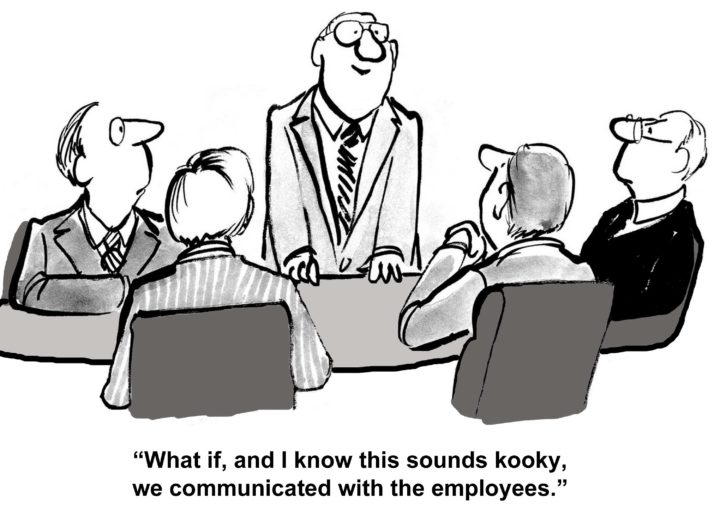Podcast: Play in new window | Download
I don’t claim to be a leadership expert, but I do believe that, as Nitin Nohria, the Dean of HBS said, “Communication is the real work of leadership.” Or, as I like to say:
“Leadership IS communication IS leadership.”
Most of what I’ve talked about in these podcasts is about informing and influencing, but as you rise in an organization you need to add one more layer: inspiration.
Inspiration is too rich for daily consumption, but now and then we need it to remind us of timeless values, of truths and not just facts, of more than bread alone. Today I cover what you talk about, and in the next podcast I cover how you say it.
Why Do You Need Leadership Communication?
First, let’s talk about why you would even need this. After all, if you rise in the organization you will have more power over those who report to you, and you may certainly be tempted to rely just on that power to convince others to do the things you want them to do.
If so, you’re making the same mistake that Dwight Eisenhower did. After a lifetime in the military, he was used to issuing orders and being reasonably confident that they would be followed. As President, he found that the order was only the beginning, not the end. It’s the same mistake that I’ve seen in some sales organizations I work with. When I warn sales leadership that implementing a new sales methodology can be difficult, most of them confidently tell me that they will mandate its use, as if that is all that needs to be done.
The old “Because I said so” model just does not work anymore. It might have worked when managers did the thinking and employees did the manual labor (and even then it had its limitations), but today almost everyone is a knowledge worker, and often they know more than you do about their jobs. Smart bosses surround themselves with even smarter people, but smart people don’t want to be led by you or anyone else—they want you to create the conditions where they can do their thing without being bothered.[1]
Or maybe you won’t go that far, but you might think that you can still use the tools that probably helped you get to where you are now—the tools of influence and credibility and logic such as I have been discussing in all my podcasts. You certainly can and you should, but keep in mind that while that skill may have led to your title, it’s possible that your title may weaken your skill. Research shows that people in power are less likely to listen to others’ opinions, and more likely to overestimate their ability to communicate; one study showed that only 31% of employees rate their leadership communication as effective.
So you definitely want to keep your skills up, but if you stay there you may at best be a superb manager, but you need different skills to be a leader on top of that. (I think the people who say it’s better to be a leader than a manager miss the whole point: they’re different skills for different situations and you can be good at both.) So you still can and should use those tools, but you can get even more out of your people with the language of leadership.
Leadership Language Builds on Persuasive Communication
When you go from manager to leader you don’t stop doing all the things that made you a good manager, you add more skills that make you a leader on top of that.
So, the first thing I’m saying is that leadership language is less about doing different things than it is about doing additional things. The items listed on the left still apply, but now so do those on the right:
| · Transactional | · Transformational |
| · Value | · Values |
| · Paycheck | · Pride and Purpose |
| · WIFM | · WIFU |
A great example of leadership communication comes from one of history’s most astute students of leadership, William Shakespeare, in Henry V.
When Henry spoke to his assembled knights and archers before the battle of Agincourt, he did not offer information. When Westmoreland wished that they had reinforcements from England, he did not say, “Men, even though we are outnumbered by the French, the greater range of our longbows will allow us to achieve fire superiority for 2 minutes before they close with us, which will allow us to degrade their fighting efficiency by 46%…” He also didn’t exhort them to fight hard because they would be able to profit from capturing French nobles and exchanging them for ransom. Instead, he appealed to values that he held dear and more importantly knew that they shared with him: honor, courage, and glory.
Values can change over time—honor, courage and glory may not be the most important values that your subordinates crave, but the feelings that values produce are timeless, primarily self-satisfaction, full engagement, and most importantly, pride.
The difference between value and values is the difference between extrinsic and intrinsic motivation, or the difference between a transaction that improves profit and a transformation that boosts pride.
Henry disdains extrinsic motivation in his speech:
By Jove, I am not covetous for gold, Nor care I who doth feed upon my cost; It yearns me not if men my garments wear; Such outward things dwell not in my desires.
He even offers payment to those who would choose value over values:
Rather proclaim it, Westmorland, through my host, That he which hath no stomach to this fight, Let him depart; his passport shall be made, And crowns for convoy put into his purse;
He then appeals to personal pride, which he knows will resonate with his listeners:
He that outlives this day, and comes safe home, Will stand a tip-toe when this day is nam’d, And rouse him at the name of Crispian. He that shall see this day, and live old age, Will yearly on the vigil feast his neighbours, And say “To-morrow is Saint Crispian.” Then will he strip his sleeve and show his scars, And say “These wounds I had on Crispin’s day.”
Even above personal pride is communal pride. Henry knows the power of appealing to a sense of belonging to something special, larger than one’s personal selfish desires:
We few, we happy few, we band of brothers; For he to-day that sheds his blood with me Shall be my brother; be he ne’er so vile, This day shall gentle his condition;
If you want to inspire, you must appeal to higher values than personal gain. WIFM (what’s in it for me?) doesn’t work for inspirational speeches, but WIFU (What’s in it for us?) does. If Kennedy had said, “let me tell you what your country can do for you,” would anyone have remembered his inaugural address?
What Do Followers Need to Hear? What is the Stuff of Leadership Communication?
I set out to write about what leaders need to say to inspire their followers, but I quickly realized that’s the wrong question. The important question is, “What do your followers need to hear?” As a leader, you are defined by the actions of your followers, and their actions depend hugely on what they hear from you. As in all communication, you need to start from their wants and needs. Just as you can’t teach unless they want to learn, and you can’t sell unless they want to buy, you can’t lead unless they want to follow.
So, what do followers need to hear?
I profoundly believe that people—most people—want more from their work than just a paycheck. Employees will try harder, think more creatively, and pour more of themselves into their work when they have three things: direction, meaning, and confidence. A leader communicates all three and inspires their best work; a manager may hit one or two one and leave potential energy unused; a mere boss ignores them and drains the life out of the workplace.
How do you choose what to say to provide direction, meaning and confidence? To simplify, let’s borrow Rudyard Kipling’s “six honest serving-men”:
I keep six honest serving-men
(They taught me all I knew);
Their names are What and Why and When
And How and Where and Who.
Although Kipling probably did not have leadership communication in mind when he wrote those words, let me explain how answering these six questions will give you the ingredients you need for inspiring leadership communication:
WHERE are we going? The word itself, lead, implies a direction and final destination, so the first task of a leader is to offer a vision of a promised land which is much better than where they are today. Whether it is Churchill’s “broad, sunlit uplands”, or Google’s more prosaic “To organize the world’s information and make it universally accessible and useful”, a shared vision guides, unites and inspires. Of course, it has to be something you truly and deeply buy into, not some buzzword-filled, meaningless pap conceived by committee.
WHY is it important? This a company’s reason for being. Jon Katzenbach said, “An intrinsic feeling of pride based on the relentless pursuit of worthwhile endeavors is a powerful motivating force.” People are inspired by meaning and purpose, by causes that are greater than themselves. Building a cathedral is more inspiring than simply laying bricks, even if the work is exactly the same. In a business environment, the purpose is unlikely to be as exalted as saving the world for democracy, but it should contain some service or benefit for customers. Put another way, what would they lose if your company did not exist?
WHO are we? There is a reason that Maslow put self-actualization at the top of his pyramid. We all have an idealized conception of who we are, and we will direct our most fervent energies and risk even our lives to act according to it. When Shakespeare’s Henry V utters the words, “we few, we happy few, we band of brothers”, he knew that every man listening would stay and fight against overwhelming odds—because that’s who they were. Today, an excellent corporate example is Ritz-Carlton’s motto: “We are Ladies and Gentlemen serving Ladies and Gentlemen.”
HOW will we conduct ourselves? This is a statement of core values that are absolutely inviolate. The old saying, “It’s not whether you win or lose, but how you play the game that counts”, may seem quaint and outdated in today’s cutthroat business world, but at the end of the day, when your followers go home, they need to feel good about themselves and be able to look themselves in the mirror and like what they see. Besides, distinctive values can also differentiate you in the marketplace and serve as a competitive advantage that is almost impossible to copy. By the way, never forget that when it comes to values, your behavior as a leader speaks far louder than any words you can ever say.
WHAT do we have to do and WHEN? You can have the most powerful vision and compelling purpose and still fail to motivate your followers if they don’t have confidence that they can succeed. You have to show that you have confidence in them, and in your ability to win with them. At the same time, answering the what and when gives them the confidence that you are the appropriate person to lead them, because you have a realistic plan.
[1] See the excellent article, “Leading Clever People”, by Rob Goffee and Gareth Jones, Harvard Business Review, March, 2007.
How well do you know your own company, and why is it important that you do?
Imagine playing on a football team where you did not know the score of the game, or even the result of the play you just ran. It would be pretty hard to get fired up about doing your best possible job, wouldn’t it? Unfortunately, that’s the mindset that a lot of companies have towards their employees. It’s even more dispiriting when employees have the same attitude towards about understanding the bigger picture of the company in which they work.
Henry Ford once complained that when he hired a hand, a head came with it. That attitude may have made sense in the days when assembly line techniques were a powerful competitive advantage, but it is sorely out of tune with today’s needs. Mindless jobs are exactly the ones that are most at risk from robotics and artificial intelligence.
People who will thrive in the years to come are those who know how to add value to their employers through the quality and relevance of their ideas, and their ability to communicate them effectively. One of the best ways to ensure this is to become a student of your own company.
The US military has accomplished tremendous things with its young officers and NCOs who shoulder tremendous responsibilities early in their twenties. One practice that helps them is a leadership concept called commander’s intent. Commanders are very open about the intent of their mission, and then leave the details for its attainment to their subordinates. This is important because things change too fast for the person on the ground to have to refer every decision up the chain. As George Patton said, “Never tell people how to do things. Tell them what to do and they will surprise you with their ingenuity.”
Your own version of commander’s intent is a deep knowledge of your company, how it serves its customers, how it competes within its industry, and what the financial “score” is. Develop it in yourself and it will help you personally; develop it in others and it will help your team and the larger organization.
The personal benefits of knowing your company are:
- You become more engaged in your work when you see how it fits into a purpose larger than yourself.
- You make better decisions under uncertainty, because they are more likely to be aligned with the company’s priorities and goals.
- You become a more credible internal communicator, because you are seen as a strategic and long-term thinker who cares for more than just your narrow short-term interests.
- You become a better communicator toward your own customers. Instead of shrugging your shoulders and spouting the “company policy” line, you can explain the reason for something or find a solution that works for both parties.
By passing on this information and skill to your own direct reports:
- They have a sense of ownership which will make them more engaged and hence more productive.
- You can manage with a much lighter touch, substituting individual judgment for detailed rules and procedures.
- You get a better flow of ideas and intelligence upward, not only because employees are more engaged but because they have a sharper sense of what’s relevant.
So, what should you do to become a student of your own company?
- Read your own company’s annual report and tune in to quarterly earnings reports. If you need to, become knowledgeable about financial statements.
- Even if you don’t have direct customer contact, know what your company’s customers need and value, and what sets you apart from the competition.
- Treat your boss and her boss as a customer; know what drives them, how they’re measured, and how you can make their jobs easier.
Peter Drucker said: the effective executive asks, “What can I contribute that will significantly affect the performance and the results of the institution I serve?”[1] If you want to be an effective executive, that starts with knowing as much as you can about the performance and results of the institution you serve.
[1] The Effective Executive, Peter F. Drucker, p. 53.
Kelly Riggs, author of Quit Whining and Start Selling, has teamed up with his son Robby to write Counter Mentor Leadership, which is a timely book on how to lead in today’s 4-Generation workplace. I personally can’t imagine how a father-son relationship could survive writing a book together, but they have somehow managed to pull it off.
I definitely recommend it as an excellent book on leadership, although I say that for different reasons than they would claim, which I will get to in a minute.
The first two sections of the book set the table by describing how today’s workplace has changed, and why leadership may be more challenging than ever. Their premise is that today’s BOSS (Boomer, Old-school Supervisors) leadership model is not effective with KIDS (Know-it-all Digital Self-promoters). Boomers, according to them, still practice the old Taylorian model of command and control management and so they’re out of step with the demands of today’s workplace, with its new technology, distractions, pace of change and complexity.
The main course of the book is section three, in which they introduce their COUNTER Mentor leadership model. The acronym describes the seven tasks of a leader:
- Communicate desired outcomes
- Own the relationship
- Understand different perspectives
- Negotiate the obstacles
- Teach essential skills
- Execute
- Review results
The prescriptions comprise solid, common sense advice for leaders. As with most leadership advice, it’s things you more or less know already but don’t do enough of. Rather than go into detail for each of these parts of the model, let me address two key points that fit the persuasive communication theme of my blog.
First, I strongly agree with Communication as not only the first piece of the model, but as the only one that merits more than 1 chapter—four chapters, in fact. As I’ve put it before with maybe just a light touch of exaggeration, leadership IS communication. As the book puts it, “everything you do is communication, and your people soak it up like a sponge.”
Second, the charge to understand the perspectives of others is absolutely critical.[1] R&R tell us that “understanding is critical to developing a relationship, and relationship is the key to trust.” The key takeaway I got from this is that both sides demand respect, but they define respect differently, which is why open conversations to understand each other’s points of view is essential. The best tool for this is the Counter Mentor 1-on-1 Meeting, which is like a sales call plan for coaching.
As I mentioned earlier, my reasons for recommending the book may differ from theirs. First, while I agree that the Taylorian model doesn’t work, that’s not exactly a new idea. Douglas McGregor called the old style Theory X and the new style Theory Y in his book, The Human Side of Enterprise, in 1960, while a few years’ worth of boomers weren’t even born yet. If bosses are still practicing the old school management today, in my view it’s a personal problem, not a generational problem.
Besides, speaking of generational conflict, we’ve always had generational differences in the workplace. (Remember the song, Signs with its lines, “Long-haired freaky people need not apply” and “Imagine that! Hah, Me working for you!”) I suspect that today’s millennials will become tomorrow’s BOSSes when they get older and get more control.
But those two quibbles are actually good reasons to buy this book and apply its lessons. People constantly need to be re-reminded of old truths, and millennials who take these lessons to heart may avoid the fate of becoming BOSSes as they grow older (yes, it’s going to happen to you before you know it—one day you’ll look in the mirror and see your Mom or your Dad).
So, yes, you need to apply the lessons in this book, but not just because there are 4 generations in the workplace. The leadership model applies regardless of the age of the participants on either side of the equation.
As Kelly and Robby stress, it’s all about respect, no matter how old you are. And I guess that’s how father and son managed to write a book together.
[1] Although they don’t specifically address it in the book, different perspectives also arise from increased diversity and cultural differences, which makes this more important than ever.
At least half my work is with mid-level up to senior managers who come from highly technical backgrounds, so I know how hard it can be for them to master the “soft skills” of effective communication. But even so, I was surprised by the extent of the problem described in this Quartz article, ”Almost 70% of US managers are scared to talk to their employees”.
The article cites research in a 2016 Harvard Business Review article which found that 69% of 616 managers surveyed confessed that “they’re uncomfortable communicating with employees”, with the biggest concern (37%) being their discomfort with giving direct feedback which their employees might take badly.
“Discomfort” may not be the same as “scared”, but if discomfort with a certain behavior prevents you from doing your job, it’s definitely a problem. If discomfort prevents you from saying what needs to be said, that’s a problem for you as a leader; it’s a problem for the employee who does not get useful feedback; and it’s a problem for the entire team.
It’s human nature to be uncomfortable delivering a difficult message, but it’s a necessary part of being a leader. The best way to get over the discomfort is to be good at it, and the only way to be good at it is to learn the appropriate skills. There’s a misconception that one automatically picks up the ability to be an effective communicator through osmosis—as is “soft” means easy. While I don’t have hard evidence, I’m convinced that the major reason for the Peter Principle is that people get promoted beyond their ability or willingness to communicate.
If you want to succeed as a leader, first you must learn to communicate. Hard skills may get you there, but soft skills will keep you there.






